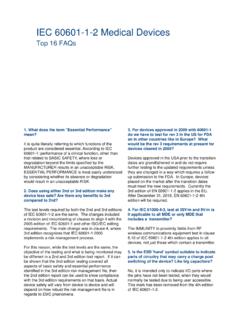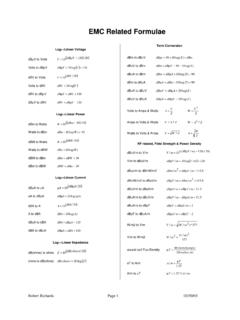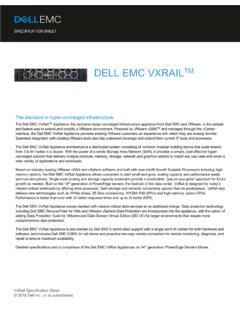Transcription of Electromagnetic Compatibility (EMC) for Active …
1 Electromagnetic Compatibility (EMC). for Active Implantable Medical Devices 1-800-WORLDLAB Electromagnetic Compatibility (EMC). for Active Implantable Medical Devices Table of Contents Introduction ..2. EMC Background ..2. EMC EMC and medical Sources of Electromagnetic disturbances ..4. Active Implantable Medical Devices ..6. Types ..6. EMC considerations ..6. How much field attenuation does the human body provide?..8. Environments and EMC Regulatory considerations: EMC ..15. United States of America ..15. European International ..16. Test requirements: EMC ..17. Cardiac pacemaker and Radio standards: Programming the implant ..21. EMC design considerations ..23. Summary.
2 24. 1. Electromagnetic Compatibility (EMC). for Active Implantable Medical Devices Introduction The role of Electromagnetic Compatibility in implantable medical device design and testing has become increasingly important as we rely more and more on electronics in our lives. During the course of a normal day, our human body can experience a large number of different Electromagnetic environments. Our homes can be relatively benign. But when we put a mobile phone to our ears, or pass through a department store security check, we are exposing our body to high levels of Electromagnetic fields. We are not normally aware of this invisible aspect of our surroundings, nor is it harmful, but when we carry an Active implantable medical device with us the results can be serious.
3 That's why manufacturers of such devices must anticipate the environments we visit - and test their devices to assure continuous, reliable operation. The Electromagnetic environments experienced by implanted medical devices are quite different from those encountered by common types of other medical electrical equipment. In this paper we will start from the basic issues of medical EMC and analyze the unique circumstances affecting Active implanted devices. EMC Background EMC definition Electromagnetic Compatibility (EMC) is defined as: The condition which exists when equipment is performing its designed functions without causing or suffering unacceptable degradation due to Electromagnetic interference to or from other equipment.
4 EMC refers to a kind of environmental equilibrium. In this case, the environment is an Electromagnetic one - consisting of invisible disturbances which travel through the air or through metal cabinets or wires. Most electrical and electronic devices generate such disturbances. And, as we have seen, many electronic devices can be upset by these disturbances. 2. Electromagnetic Compatibility (EMC). for Active Implantable Medical Devices When a particular piece of equipment is not generating excessive disturbances, and when it is operating correctly in the presence of such disturbances, the condition of Electromagnetic Compatibility is satisfied. The illustration below illustrates graphically that Electromagnetic Compatibility is comprised of the two parts: emissions that are not excessive for the intended environment, and a level of susceptibility that permits normal operation in that environment.
5 Note that there is a wide gap between the typical levels of emissions and immunity a factor of roughly 10,000. to 1. This arises because the emission limits are set to protect radio/TV broadcast receivers and other sensitive radio services, whereas the immunity limits protect the normal function of most other electronic devices. Electromagnetic Compatibility Electromagnetic Electromagnetic emissions susceptibility Radiated emission limits RF susceptibility levels 100-224 V/m Residential 3 V/m CISPR 11 Class B (3m). 316-708 V/m Industrial 10 V/m CISPR 11 Class A (3m). EMC and medical devices Electrical and electronic medical devices often operate in well-defined Electromagnetic environments hospitals, clinics, doctors' offices and our homes.
6 For these locations the circumstances of Electromagnetic Compatibility are fairly well-defined. The medical EMC. standard IEC 60601-1-2 has been adopted internationally to cover both life-supporting equipment and other types. It draws on the IEC 61000-4-x series of basic EMC standards (below). It also defines the immunity compliance criteria emission limits and changes in 3. Electromagnetic Compatibility (EMC). for Active Implantable Medical Devices equipment performance that are not allowed unless specific precautions are provided to the user. Table 1 Basic EMC standards in IEC 60601-1-2. emissions phenomenon standard typical source Radiated emissions CISPR 11 Digital electronics AC conducted emissions CISPR 11 Switching power supply Harmonic distortion IEC 61000-3-2 Switching power supply Voltage fluctuations/flicker IEC 61000-3-3 Internal load switching immunity phenomenon standard typical source Electrostatic discharge IEC 61000-4-2 Static buildup on person or object RF radiated immunity IEC 61000-4-3 radio transmitters above 80 MHz Fast transient burst (EFT/B)
7 IEC 61000-4-4 Switching noise in AC line Lightning induced surge IEC 61000-4-5 Lightning near power line RF conducted immunity IEC 61000-4-6 AM and HF mobile radio stations Radiated magnetic immunity IEC 61000-4-8 Nearby power cord Voltage dips/interrupts IEC 61000-4-11 Loads switching in AC branches Sources of Electromagnetic disturbances Electromagnetic disturbances can be generated by natural events (ESD, lightning), AC. power installations (magnetic fields, fast transients, dropouts) or nearby electrical equipment. Equipment sources of interference can be intentional or unintentional radiators. The word intentional here does not mean a deliberate source of interference.
8 Rather, it means a device that intentionally emits radio waves for communications or therapy or other useful purpose. Unintentional radiators emit radio waves as a byproduct of their normal operation. Examples of both types are given below. Intentional radiators Unintentional radiators Radio/TV stations Digital electronics Remote controls Microwave ovens Cell phones and pagers Appliances Perimeter protection (anti-theft) systems Lamp dimmers RFID scanners FM radio receivers 4. Electromagnetic Compatibility (EMC). for Active Implantable Medical Devices Radiated emissions are essential for the operation of broadcast radio and TV, public telecommunications (such as cellular telephony and paging), and private uses (such as walkie-talkies, remote controls and wireless car door keys).
9 Each of these intentional radiators is subject to rules for preventing interference and maximizing the efficient use of limited spectrum. Unintentional radiators, such as digital electronics and microwave ovens, are also governed by standards which limit the permitted emissions. These are products which are not designed to generate RF energy, but do so anyway. As a result, they can interfere with broadcast reception or the operation of other nearby electronic devices. In the United States, FCC rules govern permissible emissions from both unintentional and intentional radiators. Part 15 establishes limits for digital devices, radio receivers and low- power transmitters such as remote controls, perimeter protection systems and WiFi networks.
10 Other FCC parts regulate higher-power equipment such as cellular radio (Parts 22, 24 and 27), mobile radio (Part 90) and microwave communications (Part 101). With few exceptions, the FCC does not regulate product immunity. Medical product emissions and immunity are of concern to the US Food and Drug Administration (FDA), through its responsibility for medical device safety. It has recognized IEC 60601-1-2 as an acceptable medical EMC standard, with exceptions for specific devices such as electric wheelchairs or equipment in ambulances where high-power mobile radios may be in use. Medical equipment that uses wireless technology presents special risks for both life-supporting and other applications, and the FCC provides additional guidance here ( ).













